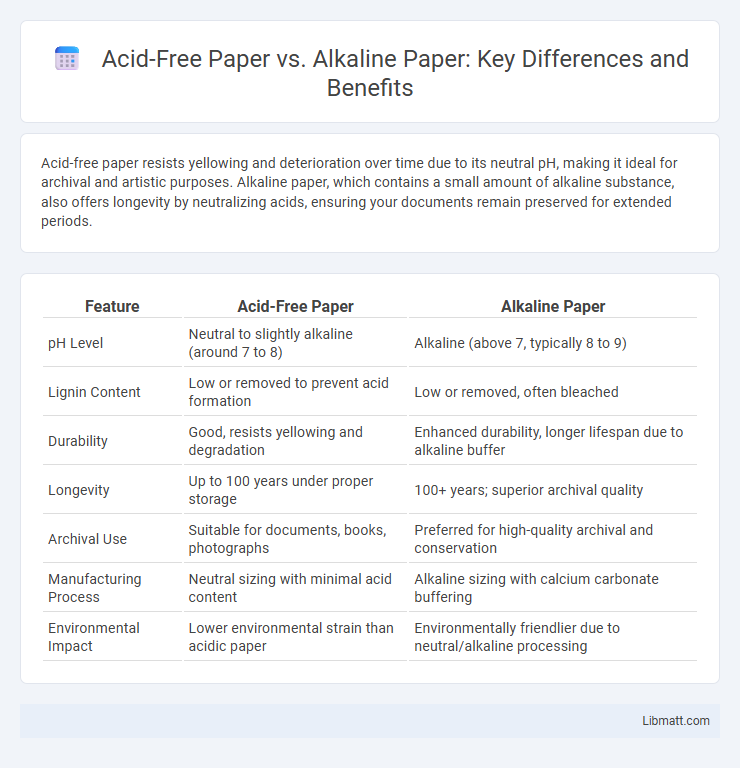Acid-free paper resists yellowing and deterioration over time due to its neutral pH, making it ideal for archival and artistic purposes. Alkaline paper, which contains a small amount of alkaline substance, also offers longevity by neutralizing acids, ensuring your documents remain preserved for extended periods.
Table of Comparison
| Feature | Acid-Free Paper | Alkaline Paper |
|---|---|---|
| pH Level | Neutral to slightly alkaline (around 7 to 8) | Alkaline (above 7, typically 8 to 9) |
| Lignin Content | Low or removed to prevent acid formation | Low or removed, often bleached |
| Durability | Good, resists yellowing and degradation | Enhanced durability, longer lifespan due to alkaline buffer |
| Longevity | Up to 100 years under proper storage | 100+ years; superior archival quality |
| Archival Use | Suitable for documents, books, photographs | Preferred for high-quality archival and conservation |
| Manufacturing Process | Neutral sizing with minimal acid content | Alkaline sizing with calcium carbonate buffering |
| Environmental Impact | Lower environmental strain than acidic paper | Environmentally friendlier due to neutral/alkaline processing |
Introduction to Acid-Free and Alkaline Paper
Acid-free paper is manufactured with a neutral or slightly alkaline pH, typically around 7 or higher, preventing deterioration and yellowing over time. Alkaline paper contains a higher level of alkaline substances, such as calcium carbonate, which acts as a buffer against acid exposure and enhances durability. Both acid-free and alkaline papers are widely used in archival and preservation contexts to ensure longevity and resistance to aging.
Understanding Paper Acidity and Alkalinity
Acid-free paper maintains a neutral or slightly alkaline pH, typically around 7 or higher, which prevents the degradation caused by acidic components over time, making it ideal for archival and long-term preservation. Alkaline paper contains buffering agents such as calcium carbonate that neutralize environmental acids, enhancing durability and resistance to yellowing and brittleness. Understanding the pH balance in paper manufacturing is crucial for selecting materials that ensure longevity and protect sensitive documents or artworks from acid-induced damage.
Manufacturing Processes: Acid-Free vs Alkaline Paper
Acid-free paper is manufactured using a neutral or slightly alkaline pulp, often treated with calcium carbonate to maintain pH levels around 7 or higher, preventing acid degradation. Alkaline paper production involves adding alkaline substances such as calcium carbonate or magnesium carbonate to pulp, resulting in a pH level typically between 7.5 and 10, which enhances durability and resistance to yellowing. Both processes emphasize the use of calcium carbonate as a buffering agent, but alkaline paper usually provides better longevity due to its higher pH stability and improved neutralization of acidic contaminants.
Key Benefits of Acid-Free Paper
Acid-free paper offers superior longevity and durability compared to alkaline paper, as it resists yellowing and degradation caused by acidic substances. This type of paper is ideal for archival purposes, preserving documents, artwork, and photographs for extended periods without deterioration. Its neutral pH level also prevents chemical reactions that can weaken fibers, ensuring the material remains stable over time.
Advantages of Alkaline Paper
Alkaline paper offers superior longevity compared to acid-free paper due to its higher pH level, which prevents acid deterioration and yellowing over time. It contains calcium carbonate as a buffer, providing enhanced resistance to environmental pollutants and moisture. Your documents printed on alkaline paper maintain clarity and durability, making it ideal for archival-quality records and important publications.
Longevity and Preservation Qualities
Acid-free paper, with a neutral or slightly alkaline pH, offers superior longevity and resistance to yellowing and deterioration, making it ideal for archival documents and artwork preservation. Alkaline paper, often buffered with calcium carbonate, enhances durability by neutralizing acidic compounds over time, thereby extending the lifespan of printed materials. Both acid-free and alkaline papers significantly surpass traditional acidic papers in preserving the integrity and appearance of important documents for decades.
Environmental Impact and Sustainability
Acid-free paper, produced with neutral or slightly alkaline pH, offers enhanced longevity and reduced chemical deterioration, making it more environmentally sustainable by minimizing harmful acid runoff during decomposition. Alkaline paper, often made using calcium carbonate fillers, supports better recycling processes and decreases reliance on acidic bleaching agents, contributing to lower environmental pollution and resource conservation. Both types promote sustainability, but alkaline paper's improved durability and eco-friendly manufacturing align more effectively with modern environmental standards.
Common Uses in Printing and Archival Work
Acid-free paper is widely preferred for archival work due to its longevity and resistance to yellowing, making it ideal for preserving important documents, photographs, and artworks. Alkaline paper, which often contains a mild buffering agent, is commonly used in everyday printing and publishing because it offers durability and better print quality for magazines, books, and office documents. Your choice between acid-free and alkaline paper should depend on whether you need long-term preservation or high-quality, cost-effective printing for routine materials.
Cost Comparison: Acid-Free vs Alkaline Paper
Acid-free paper typically costs more than alkaline paper due to its higher-quality production process designed to resist yellowing and deterioration over time. Alkaline paper, also known as acid-free with a pH above 7, offers a balance between affordability and durability, making it a popular choice for archival documents and printing. Your choice between acid-free and alkaline paper should consider both budget constraints and the longevity requirements of your project.
Choosing the Right Paper for Your Needs
Selecting between acid-free and alkaline paper depends on your project's longevity and archival needs. Acid-free paper offers superior durability for preserving documents, photos, and artwork, as it resists yellowing and deterioration over time. Alkaline paper contains a neutral or slightly basic pH, making it less prone to acid-related damage, often used for everyday printing and general purposes where long-term preservation is less critical.
acid-free paper vs alkaline paper Infographic

 libmatt.com
libmatt.com